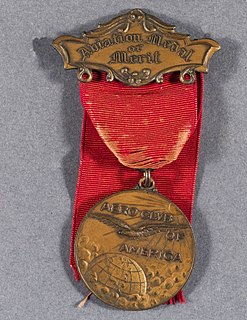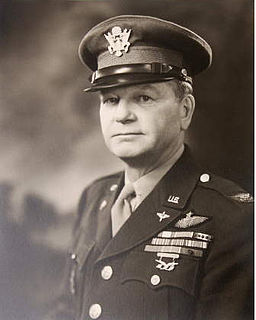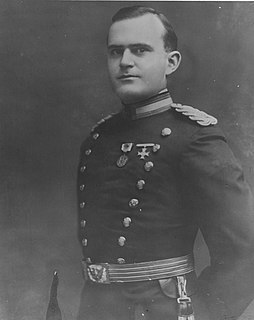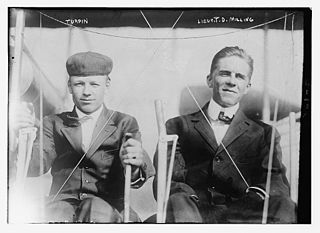
The Wright Flying School, also known as the Wright School of Aviation, was operated by the Wright Company from 1910 to 1916 and trained 119 individuals to fly Wright airplanes.

The Wright Flying School, also known as the Wright School of Aviation, was operated by the Wright Company from 1910 to 1916 and trained 119 individuals to fly Wright airplanes.
Orville Wright began training students on March 19, 1910 in Montgomery, Alabama at a site that later became Maxwell Air Force Base. With the onset of milder weather that May, the school relocated to Huffman Prairie Flying Field near Dayton, Ohio, where the Wrights developed practical aviation in 1904 and 1905 and where the Wright Company tested its airplanes. They also had a facility in Augusta, Georgia run by Frank Coffyn. [1] Some of the earliest graduates became members of the Wright Exhibition Team.


This is a list of aviation-related events from 1912:

The Aero Club of America was a social club formed in 1905 by Charles Jasper Glidden and Augustus Post, among others, to promote aviation in America. It was the parent organization of numerous state chapters, the first being the Aero Club of New England. It thrived until 1923, when it transformed into the National Aeronautic Association, which still exists today. It issued the first pilot's licenses in the United States, and successful completion of its licensing process was required by the United States Army for its pilots until 1914. It sponsored numerous air shows and contests. Cortlandt Field Bishop was president in 1910. Starting in 1911, new president Robert J. Collier began presenting the Collier Trophy.

Calbraith Perry Rodgers was an American aviation pioneer. He made the first transcontinental airplane flight across the U.S. from September 17, 1911, to November 5, 1911, with dozens of stops, both intentional and accidental. The feat made him a national celebrity, but he was killed in a crash a few months later at an exhibition in California.

Philip Orin Parmelee was an American aviation pioneer trained by the Wright brothers and credited with several early world aviation records and "firsts" in flight. He turned a keen interest in small engines into employment with the Wright Company in its early years and was one of several young pilots hired by the Wright brothers to demonstrate and publicize the capabilities of their airplanes. Because of his youth, blond good looks, and daring reputation, Parmelee had the nickname "Skyman" attributed to him.

Hendon Aerodrome was an aerodrome in London, England, that was an important centre for aviation from 1908 to 1968.

Thomas Scott Baldwin was a pioneer balloonist and U.S. Army major during World War I. He was the first American to descend from a balloon by parachute.

Katherine Stinson was an aviation pioneer who in 1912 became the fourth woman in the United States to earn the FAI pilot certificate. She set flying records for aerobatic maneuvers, distance, and endurance. She was the first female pilot employed by the US Postal Service, and the first civilian pilot to fly the mail in Canada. She was also one of the first pilots to ever fly at night and the first female pilot to fly in Canada and Japan.

Thomas DeWitt Milling was a pioneer of military aviation and a brigadier general in the U.S. Army Air Corps. He was the first rated pilot in the history of the United States Air Force.

The Aeronautical Division, Signal Corps (1907–1914) was the first heavier-than-air military aviation organization in history and the progenitor of the United States Air Force. A component of the U.S. Army Signal Corps, the Aeronautical Division procured the first powered military aircraft in 1909, created schools to train its aviators, and initiated a rating system for pilot qualifications. It organized and deployed the first permanent American aviation unit, the 1st Aero Squadron, in 1913. The Aeronautical Division trained 51 officers and 2 enlisted men as pilots, and incurred 13 fatalities in air crashes. During this period, the Aeronautical Division had 29 factory-built aircraft in its inventory, built a 30th from spare parts, and leased a civilian airplane for a short period in 1911.

The Wright Exhibition Team was a group of early aviators trained by the Wright brothers at Wright Flying School in Montgomery, Alabama in March 1910.

Frank Trenholm Coffyn was a pioneer aviator.

George William Beatty was an American pioneer aviator who set early altitude and distance records, including one record set on the same day that he flew his first solo flight.

Arthur L. "Al" Welsh was a Russian-born American pioneer aviator who became the first flight instructor for the Wright Brothers. He was killed in an aircrash in 1912.

Leighton Wilson Hazelhurst Jr. was a pioneer aviator who was killed in an aircrash with Al Welsh piloting. Hazelhurst was the third United States Army officer to die in an aviation accident. The two to die before him were Thomas Etholen Selfridge and George Edward Maurice Kelly.

George Edward Maurice Kelly was the 12th pilot of the U.S. Army's Aeronautical Division, U.S. Signal Corps and the first member of the U.S. military killed in the crash of an airplane he was piloting. He was the second U.S. Army aviation fatality, preceded by Lieutenant Thomas Selfridge, who was killed while flying as an observer in a Wright Flyer piloted by Orville Wright on 17 September 1908.

James Clifford Turpin was a pioneer aviator with the Wright Exhibition Team.

Harry Nelson Atwood was an American engineer and inventor known for pioneering work in the early days of aviation, including setting long-distance flying records and delivering the first delivery of air mail in New England.

Max Lillie was a Swedish born American pioneer aviator and flight instructor.
Philip Parmelee, the aviator, was killed here today while giving an exhibition flight from the fair grounds. Parmalee was the flying partner of Clifford Turpin, whose airship flew into the grandstand at Seattle Thursday, killing two persons and injuring fifteen.
Aviation Star Has Fatal Fall. Graduate of Wright School Meets His Death at North Yakima, Wash. Biplane in High Wind Flutters and Dives from Four Hundred Feet. His Fiancee Is Among First to Reach Crushed Body of Fallen Birdman. Gives Life as Toll to Aerial Navigation.
Lieut. Leighton W. Hazelhurst, Jr., of the Seventeenth Infantry, one of the most promising of the younger aviators of the army, and Al Welsh, one of the most daring professional aviators in America, were instantly killed in a flight at the Army Aviation School at College Park, Md., at 6:30 o'clock this evening.